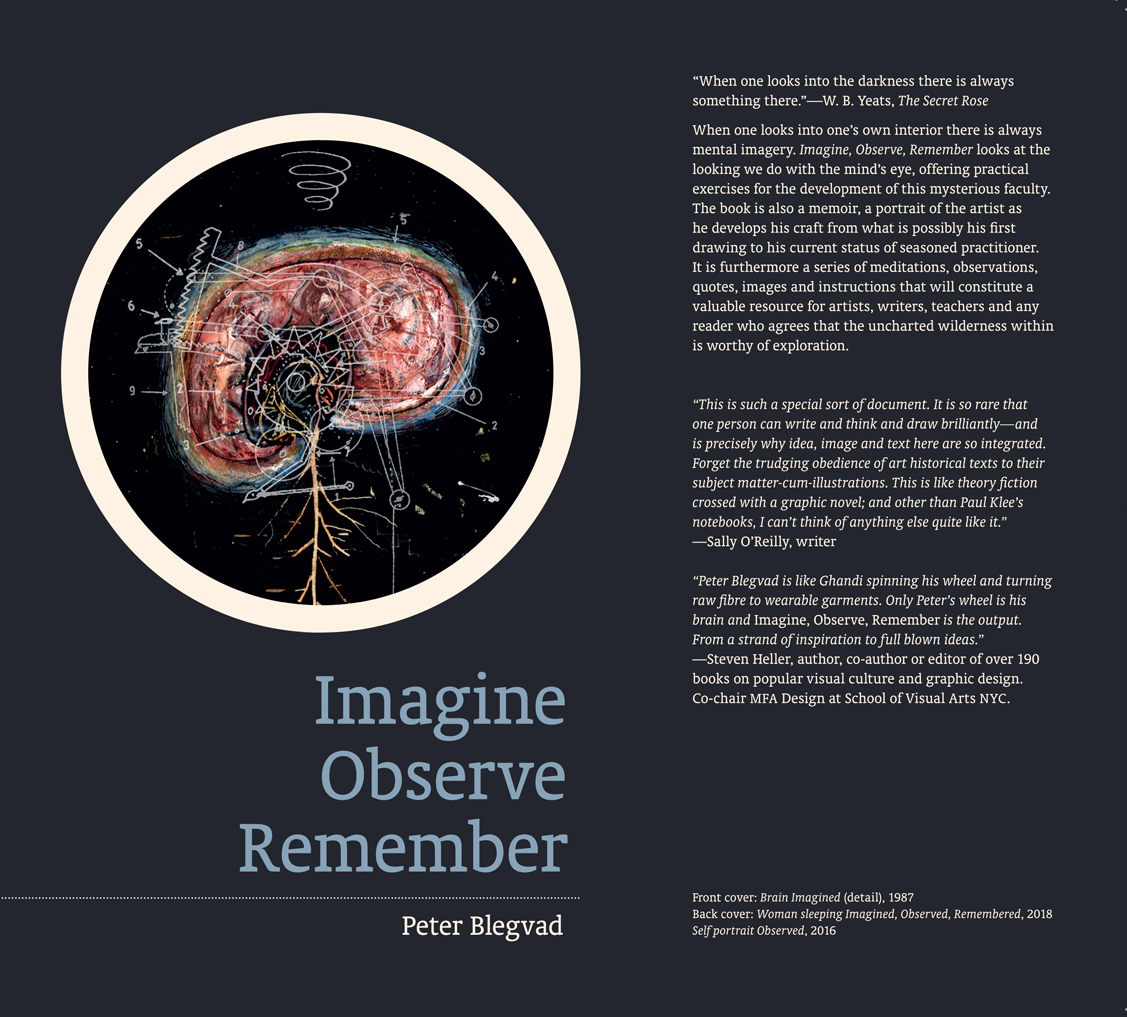
Approximately forty-give-or-take-a-year-or-two-years ago, I met Peter Blegvad at 7:00 a.m., my usual portfolio review time, in my New York Times office. Although we were both bleary-eyed, I was as impressed with his range of work—comic strips (he created the strip Leviathan), illustration, music—then as I am today. Born in the United States, he’s lived in England for most of his life, so I was taken with the hybrid American timbre mixed with London intonation. He assumed the role of a philosopher-artist for whom traditional pen and ink illustration was a means to an end. However, I’m not exactly certain whether he knew or found that end then or now. I’m always getting copies of his recent endgames in the mail. Three years ago it was “Gonwards”, a boxed set of CDs and DVDs, last year it was two books in one, Milano Eagles & The Marvelous Moo, which took 40 years to make and its byline reads Björn d'Algevey, an exquisite corpse, of Blegvad and the late Pushpin Studios illustrator-storyteller Jerry Joyner.
This year Blegvad sent me another type of surprise altogether that is a small part art book, an even smaller part memoir and mostly a treatise (more like a treat) that serves as therapy for him and mind expansion for readers. The poetically enigmatic title says it all: Imagine, Observe, Remember; it is a book about process, memory, remembrance and interpretation. “When I began doing comparative drawings of things imagined, observed and remembered, I was an illustrator looking for a story to illustrate. Something with a beginning, middle and end,” Blegvad writes in his foreword or “Disjecta Membra” (scattered fragments) of Imagine, Observe, Remember. . . “It began as a way to think about illustration. It became a way of using illustration to think about imagining, observing and remembering. It’s a kind of phenomenology project, a way to look at different ways of looking and seeing, using the means at my disposal, using myself as subject.” After reading it twice, I thought it would nice if Blegvad provided insight into this practical theoretical philosophical wonderment.
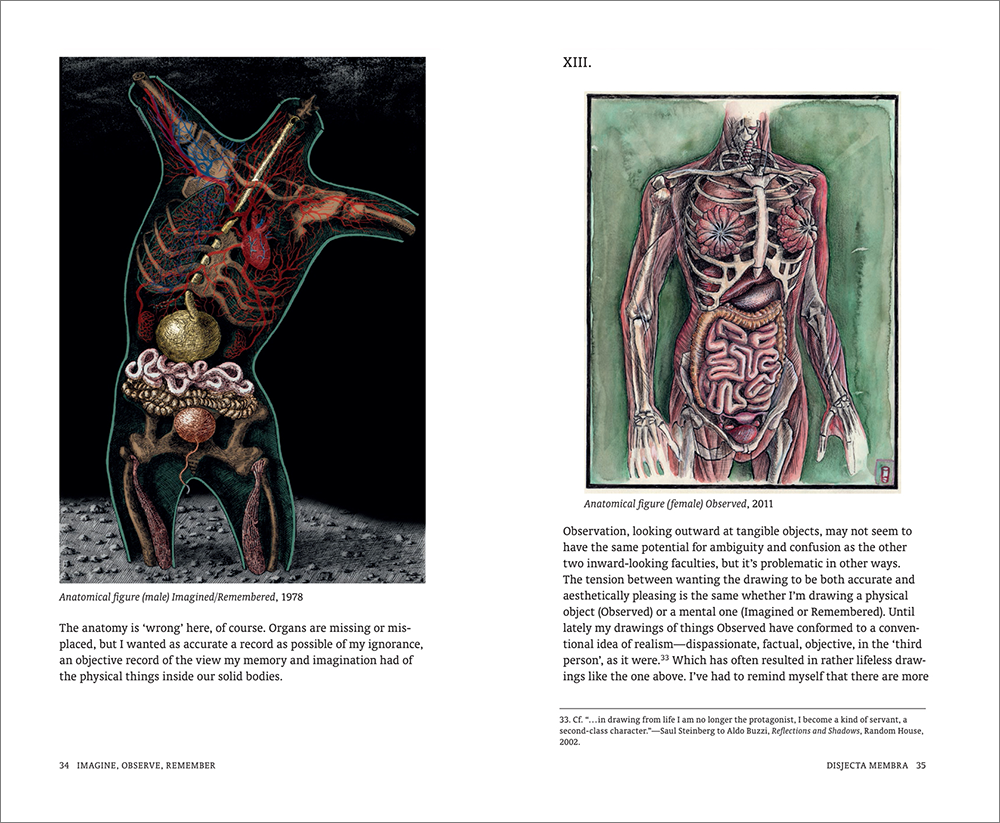
Steven Heller: You write that the book “became a kind of phenomenology project, a way to look at different ways of looking and seeing using the means at my disposal, using myself as subject.” Does this mean that it is a memoir or something other?
Peter Blegvad: There are bits of memoir interspersed throughout, but the book is something very ‘other’. The writer Sally O’Reilly says it’s “like theory fiction crossed with a graphic novel; and other than Paul Klee’s notebooks, I can’t think of anything else quite like it.” It starts like a memoir, looking back to when I began the project, 45 years ago. But as memoir it’s unreliable, as memory is. The story I tell about how and why I began drawing things X 3 could be told differently, like this for instance:
Someone once dared to ask “What’s the point? Why bother to make comparative drawings of things depicted thrice?” One answer is that I was curious to see which of the three faculties—Imagination, Observation, or Memory—inspired the better drawing. (And, because I doubted my ability to draw well, I adopted a pseudo-scientific approach in order that my work might transcend critical evaluation on purely aesthetic grounds. I wanted to escape the tyranny of criticism, including self-criticism.)
In the book I describe how the basic idea of drawing things X 3—imagined, observed, remembered—was inspired by my struggle to develop a style as an illustrator. I liked accurate mimetic drawings, based on observation, but I also liked distortion, abstraction and stylization, based more on imagination and memory. So I was experimenting with these different approaches, drawing things as I pictured them mentally and then drawing them again from life, in order to help me decide which approach to follow. As I grew more adept at drawing my mental images of things, I began to find them as interesting, in their flawed imperfect way, as the things they were images of. So gradually my focus shifted from thinking about illustration to using illustration to think about how we imagine, observe, and remember.
There’s also a memoir-like section about my parents—Erik and Lenore Blegvad—who were both artists and who were my primary influences.
The sections devoted to my own experiments aren’t exactly memoirs, but as records of past activity there’s an aspect of that to them.
But other sections of the book are based on workshops I taught over the years and are concerned with visualization exercises for writers and illustrators, with hypnagogic vision, with the poetics of failure, with encyclopaedias, with ancient Greek mnemonic techniques, with the history of cognitive science and eccentric figures like Sir Francis Galton, the Victorian polymath who’s probably mainly infamous now as the founder of eugenics, but who was also a pioneer psychonaut who performed strange experiments on himself in order to catch a glimpse of his own mental processes at work. I like the problems that arise when the mind tries to observe itself. It’s a conundrum, like trying to taste your own tongue. It might be impossible, but one can proceed as if it wasn’t.
So, I’d say the book is less a memoir than an extended Surrealist experiment designed to encourage the idea of using oneself as a laboratory.
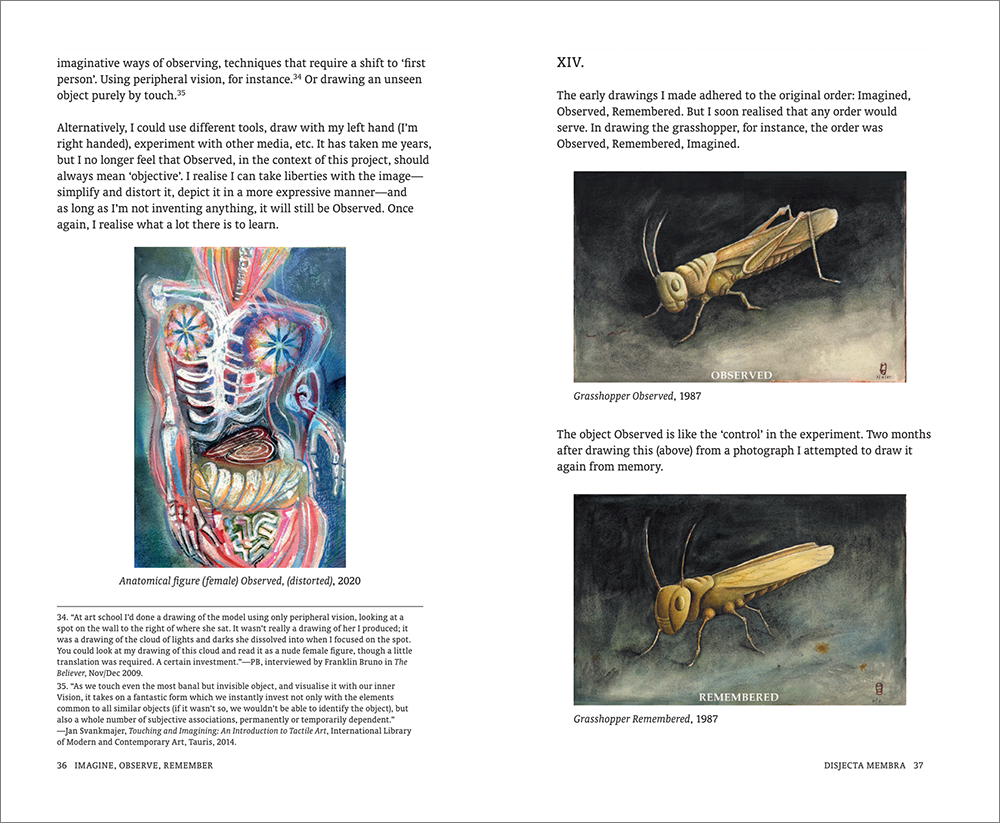
SH: There is a large amount of philosophical discourse with yourself. What are the main questions you want to answer? And what have you succeeded or failed in answering?
PB: Questions: What is real? What isn’t? Where does the life live? Is it necessary to forget in order to imagine? What is the nature of the phenomena one ‘sees’ with the mind’s eye? What is the nature of this ‘seeing’? How might such phenomena be translated into visible images? What is lost, what is gained in the process? How do we know—or think we know—what we think? Do we discover or create—observe or imagine—mental images? What moral obligation—if any—does imagination have to truth?
To me, these aren’t just questions they’re mysteries. Where does the life live? One answer might be: mystery is where the life lives. The mind—consciousness—is a mystery, maybe the deepest. Nabokov said, consciousness “…is the only real thing in the world and the greatest mystery of all”. A question I ask more than once: What’s the point? Instead of an answer I quote Jenny Diski: “Perhaps the point of asking questions is not to receive an answer but to reiterate and refine the question itself. I’m inclined to think that there is, essentially, only one question. It is ‘What is the point?’ and in some form or another it is asked over and over again by those of us who have failed to mature enough to stop asking it.”
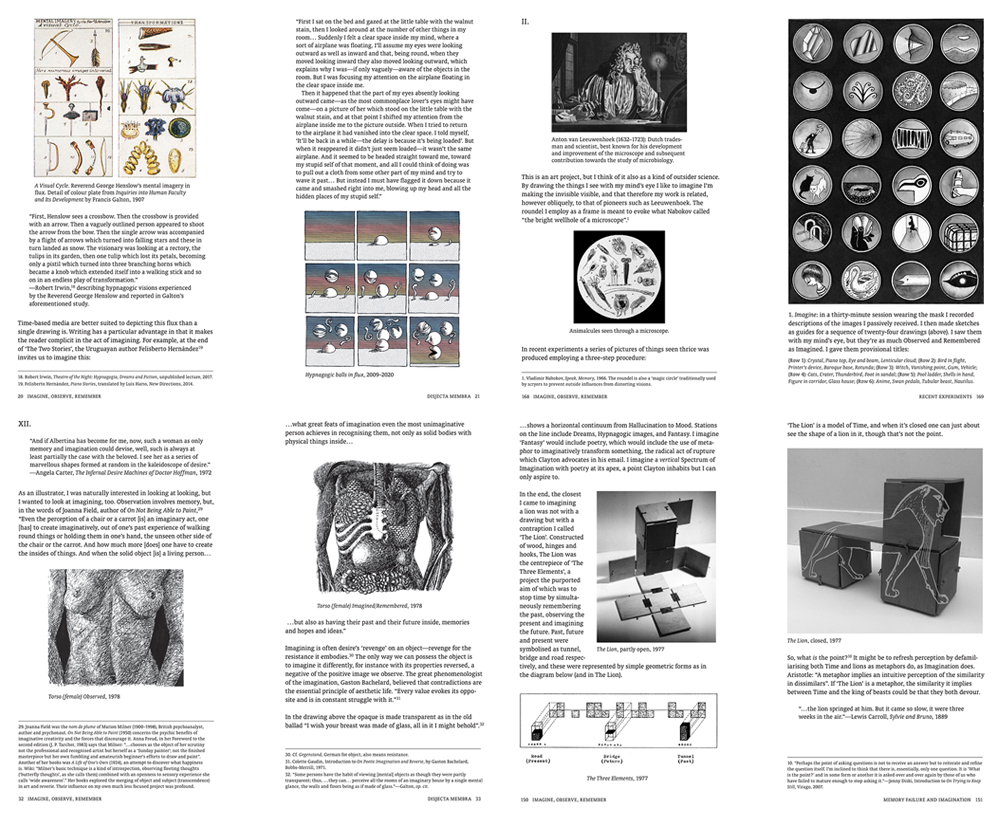
SH: I’ve not read a book that dives as deep into the weeds as this, what triggered you to delve so deeply?
PB: Curiosity, perversity, excitement at the discoveries I was making. Over 45 years one thing led to another. I began very much with the sense of it being a lifelong labour. I needed some monumental encyclopaedic mission to distract and protect me from the void—my ‘self’—and maybe to precipitate a ‘second birth’, because the first hadn’t quite done the trick. It worked, more or less...
SH: You write: “Although much of my work has been in black and white, color will be examined in different lights.” What as an artist is first and foremost important about color?
PB: That bit now reads: “Color will be examined in different lights, especially the indeterminate colour of dreams and mental images.” Color (to revert to the US spelling) is another mystery, like music. When I use color in an illustration it’s often merely pragmatic, a way to direct the viewer’s eye. And, if I’m lucky, to create mood, atmosphere. I’m married to a brilliant colorist, the painter Chloë Fremantle. Most of the little I know about color I’ve absorbed from her. I guess what’s important might be to do with the energies colors generate in us. A good colorist knows how one color affects another, and how they affect us psychologically and emotionally by their harmony or dissonance. Looking at Hilma af Klint’s large abstractions, for instance, is like taking a bath in color, it’s exhilarating, energizing, purifying somehow.
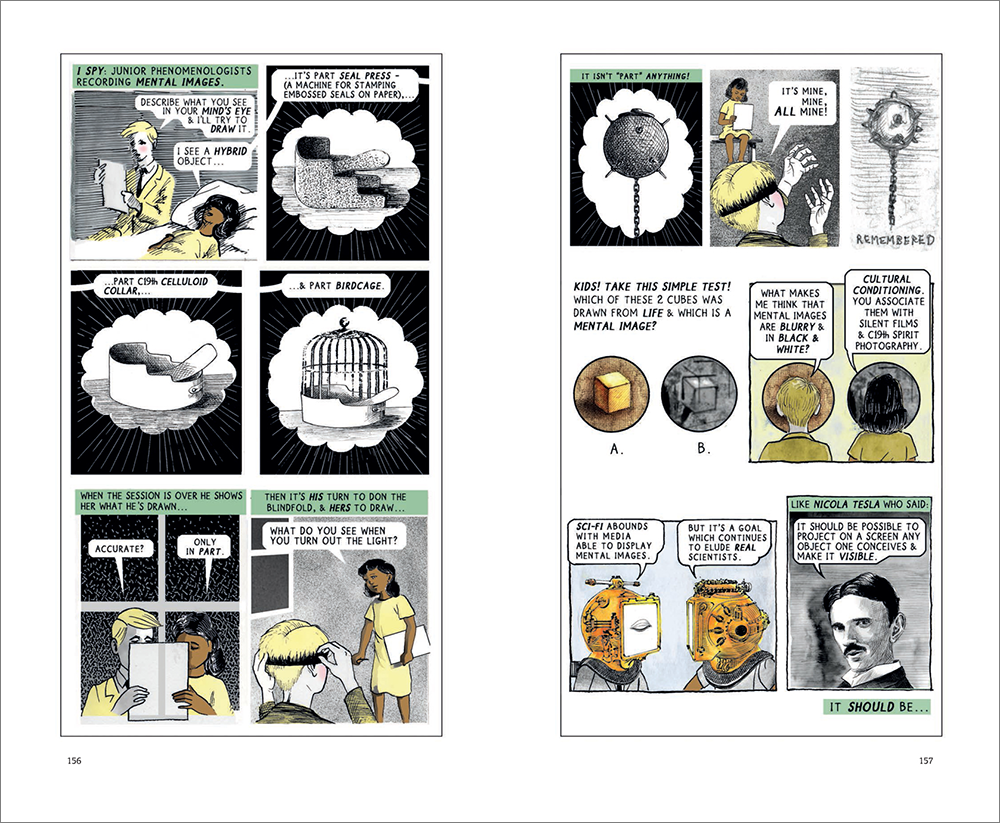
SH: How does Everyman’s Encyclopedia operate in the way you think and make?
PB: Part of the appeal this project has for me is its encyclopaedic scope. As kids, many of us experienced a ‘nostalgia for the infinite’. I never grew out of it. But I relate to the “perverse post-Enlightenment desire… to attempt the encyclopaedic and at the same time run it aground” identified by Swiss artist duo Fischli and Weiss (in an article by Randy Kennedy in the New York Times, 2 February 2016, ‘Fischli and Weiss: Anarchy at the Guggenheim’).
In 1985 I used an old copy of Everyman’s Encyclopaedia (the 1932 edition) as the source for a series of drawings of things beginning with ‘L’ imagined, observed, remembered. Laburnum, Liszt, Loch Lomond, Lion... These are all reproduced in the book. Why ‘L’? No particular reason. For the L of it. But I liked the air of obsolescence the images in the encyclopaedia had. I tried to imbue my drawings with some of their penumbral mystique.
SH: Is it possible to see things that are not there? Other than hallucination, that is?
PB: I think most of us do it all the time without being aware, and the ability—the awareness—can be ‘educated’ (trained). Eva Brann: “…our mental life is almost continuously filled with images, noticed or unnoticed (where unnoticed does not necessarily mean unconscious, but merely unattended to).” —The World of the Imagination: Sum and Substance. In my experience, noticing and attending to these things can be rewarding in unpredictable ways. Because they’re mysterious, and, as said, mystery is where the life lives.
“Once you let them in, you’ve already done the first and
most critical thing, you’ve honored that information by including it.
And by doing that you’ve actually changed the world. It’s nothing
mystical, but you’ve redefined the world for yourself.”—Robert Irwin
As I say in the book, you may not be able to converse with the ghost of a flea while sketching its portrait like William Blake did, but your capacity for seeing things that aren’t there can be demonstrated by visualising a capital letter N and rotating it ninety degrees clockwise. What letter is it now?
SH: What is what you call “a memory ghost”? Do we all have them or just a lucky few?
PB: They’re most commonly people from one’s past, but one can be haunted by sensations, by sounds, by language, or by objects too—a remembered room or house, for instance, or the car you rode in as a child. Some people are haunted by old phone numbers or mathematical equations. There can’t be many people—except maybe the very young—who aren’t haunted by something or someone from time to time.
